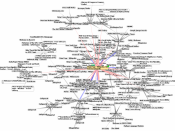Introduction
Of the five senses, the one individuals use most when browsing the world wide web (www) is sight. The www is a highly visual medium with text, graphics, animations, colors, an occasional video clip and various combinations of these elements. There are also some aural cues - audio to go along with video clips and animations, and assorted beeps, honks, bells and other noises that may warn of an incorrect entry. In addition, there must be a means to somehow input information usually through a keyboard and/or mouse to make selections, do searches, type in URL addresses, usernames, and passwords.
Most people are familiar with on-going accommodations for those with disabilities, especially during the last decade, with the implementation of the American's with Disabilities Act (ADA) to enable equal access. In this author's view, this access has been slower in coming to the www and those companies that make products to enhance our web experience.
There are efforts currently underway to generate guidelines for designing accessible web sites, such as:
W3C Web Accessibility Initiative (W3C) at http://www.w3.org/WAI/
National Center for Accessible Media (NCAM) at
http://www.wgbh.org/wgbh/pages/ncam/webaccess/index.html
Basically these sites describe fairly easy ways to incorporate information on a web site so it is accessible to those with disabilities. This essay will cover adapting a web site for blindness, and briefly reviews a web site called Bobby that automatically checks web pages for accessibility.
Designing Web Pages for People with Blindness
People with blindness can access the web by using a screen reader such as JAWS. These readers use the computer's sound card and literally read the web page. Most readers also have a feature to "tab" through links on a page. Obviously, text based pages are quite straightforward and easy to interpret. But how are graphics, animations and video handled?...


